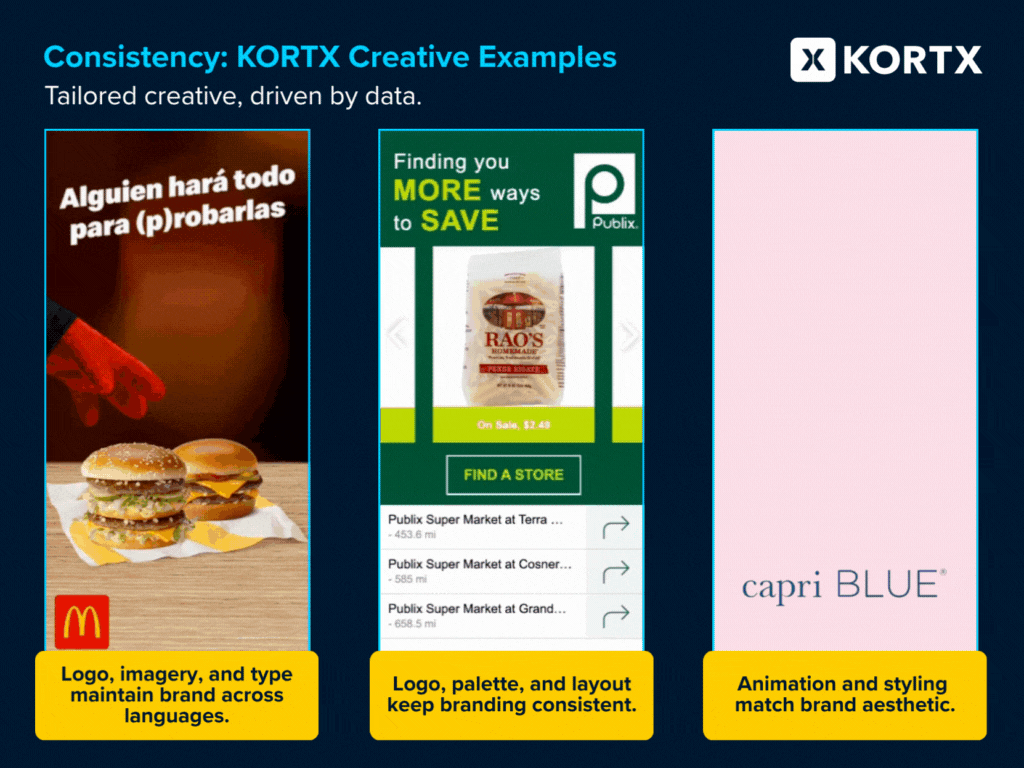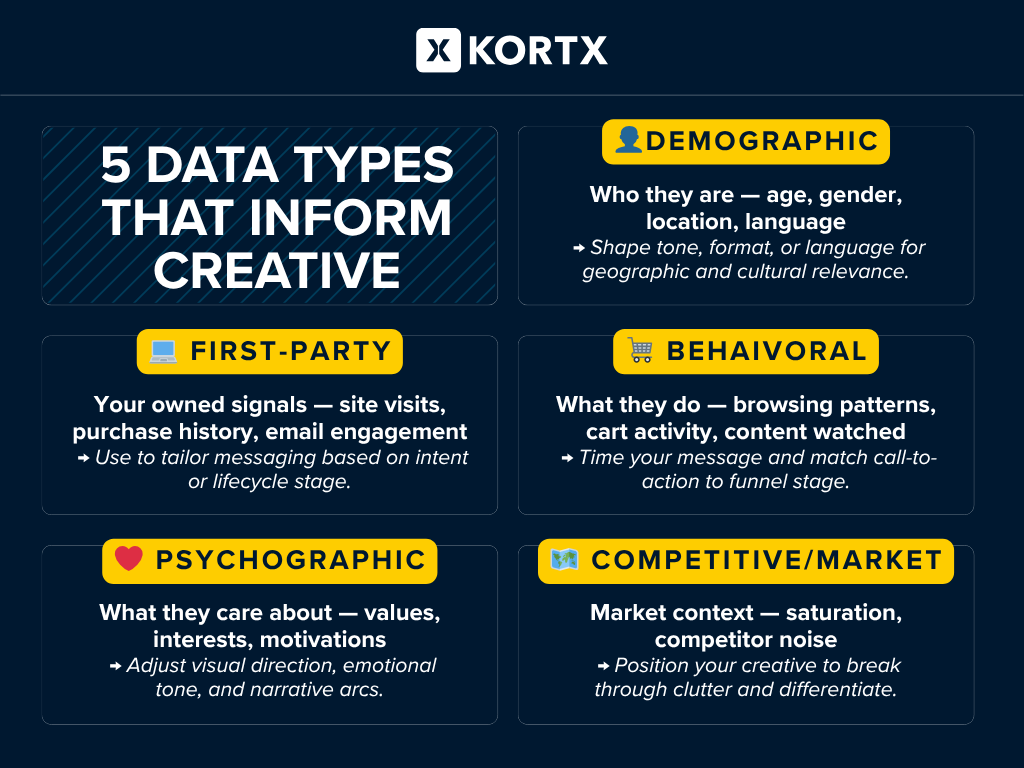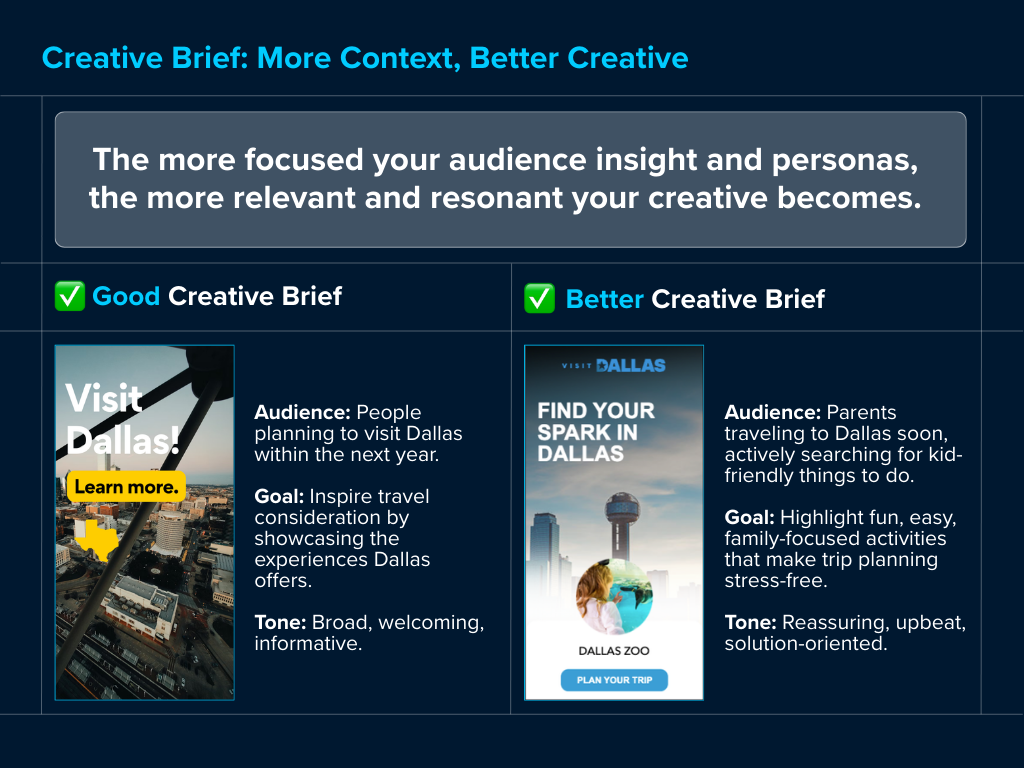You’ve got the data. The targeting. The placement dialed in.
But is your creative team using data in the same way?
A 2023 Nielsen study found that creative accounts for 65% of sales lift in digital campaigns. It’s the single biggest lever you have and often the most neglected.
Why? Because many marketers don’t know how to pull insights into the creative process. And it shows. There’s no “creative brief” button in your dashboard. Designers and spreadsheets do not mix. Empowering your design team with the correct info is a whole new skill.
Data needs to be interpreted, humanized, and turned into messaging that actually moves people.
This guide will show you how to turn audience insights into inspired creative, starting with better briefs.

The 3 C’s of Data-Driven Creative
Audience insights are only valuable if they translate into creative decisions. Marketing teams aren’t short on audience data. They’re short on clear ways to turn it into a creative direction.
That’s where the 3 Cs come in. Context, Customization, and Consistency bring structure to the creative process and help teams move from generic messaging to insight-driven execution.
1. Context
Context helps you design for where and how your audience is engaging. Use it to guide format, tone, and placement.
- Demographics like age and location shape design and message length. A younger audience may prefer bold visuals and short-form video; older groups might engage more with structured, long-form content.
- Platform behavior affects format. Mobile-first users may favor vertical or interactive formats; desktop users often use carousel or editorial-style ads.
- Content environment matters. Ads should feel relevant in their surroundings while still standing out.

2. Customization
Customization helps you speak to what your audience cares about, without crossing into over-personalization.
- Behavioral signals like content engagement or purchase activity help match the message to intent. DIY-focused users may prefer how-to content; aspirational shoppers may lean toward lifestyle-driven creative.
- Psychographics, interests, values, and preferences add emotional depth. These signals inform tone, visuals, and narrative direction.
- Design with flexibility in mind. Creating minor variations in messaging or visuals makes it easier to adjust ads and messaging for different audiences without rebuilding from scratch.

3. Consistency
Data should inform creative, not override your brand. Stay consistent by setting clear boundaries.
- Define creative guardrails—tone, voice, color, and other non-negotiables.
- Use testing to optimize within those limits, not start over each time.
- Make sure every variation reinforces your core message, even as you tailor by audience.

What Data Really Drives Great Creative
Audience insights only matter when they lead to smarter creative decisions. The key is knowing which signals to use and how to apply them.
These five data types offer the clearest direction for creative strategy. Each ties directly to planning, designing, and optimizing channel creative choices.
First-Party Data:
Start With What You Own
Site visits, product views, and past purchases offer a direct line to user intent.
Real-World Example: In a paid search campaign, use product-level browsing data to tailor ad copy at the ad group level, highlighting categories for users who viewed but didn’t convert.
Demographic Data:
Ground the Message
Age, region, and language preferences shape where and how a message lands.
Real-World Example: A national retailer uses demographic data in a programmatic display campaign to serve in-language creative with region-specific offers tailored to Spanish-speaking DMOs.
Psychographic Data:
Fuel the Narrative
Interests, preferences, and values guide tone, imagery, and storytelling with emotional relevance.
Real-World Example: For a QSR brand running paid social, build creative around an audience’s love of live sports. Use game-day visuals and deploy during peak match windows to drive local awareness and delivery orders.
Behavioral & Intent Data:
Follow the Signals
Signals like cart abandonment or product comparisons show where someone is in the journey, and what type of creative will move them.
Real-World Example: In a CTV campaign, use page revisit data to split delivery. Serve short, high-frequency spots with clear CTAs to mid-funnel users. Use longer brand storytelling formats to engage new visitors.
Competitive & Market Data:
Position to Stand Out
Market trends and competitor benchmarks reveal where others are flooding the feed and where you can take a different approach.
Real-World Example: In a paid social campaign for a crowded retail category, competitor monitoring reveals a common trend: everyone is leading with promos. To stand out, shift your creative strategy to emphasize product benefits and value, helping your ads break through the noise.

Personalization Without Overstepping
Applying the right audience signals sharpens every stage of the creative process. Strong insights lead to stronger ideas, briefs, and outcomes. Just don’t be creepy about it.
A Pew Research Center survey conducted in May 2023 found that 71% of U.S. adults are very or somewhat concerned about how companies use their personal data, reflecting widespread apprehension about data privacy.
Here’s how to personalize with purpose, backed by data, without crossing the line.
Use Data to Guide, Not Expose
Avoid referencing specific actions in creative. Instead of saying “We saw you looking at this,” use framing that draws from shared behaviors, like “Top picks for skincare lovers.” It’s relevant, but it doesn’t feel like surveillance.
Segment by Persona, Not Identity
Persona modeling helps you build smart audience groupings based on behavior, preferences, and context. Think “frequent traveler” or “budget-conscious beauty buyer”, not one-to-one personalization that can be invasive.
Be Transparent and Trustworthy
Consumers want to understand why they’re seeing what they’re seeing. That transparency often lives on the platform (via “Why am I seeing this?” tools), but brands still have a role. Where possible, like in opt-in email flows that sync with ad targeting, make your logic clear. It shows respect, and it builds long-term credibility.
“Good advertising feels like a recommendation. Bad advertising feels like a breach.”
“As designers, we shape how that feels. It’s not just what we say but how it shows up. Are we matching the mood of the platform? Does the layout feel intentional or automated?Avoid targeted language or visuals that scream “we’ve been tracking you.” Use design to guide, not corner. Thoughtful typography, calm pacing, and honest messaging go further than forced personalization.
The goal isn’t to show off the data. It’s to create a moment that feels natural. When an ad fits the experience, people welcome it. That’s the difference good design makes.”
Brand Identity ≠ One-Size-Fits-All
Strong creative adapts to your audience. But adaptation shouldn’t come at the cost of brand integrity.
Here’s how to stay flexible without losing focus.
1. Define Creative Guardrails
Lock in the non-negotiables—tone, voice, color, logo usage, messaging principles. These elements create consistency, no matter how creative flexes for different segments.
Real-World Example: In a CTV or display campaign, use dynamic creative to localize imagery or CTA language by market, while keeping brand tone and visual hierarchy consistent.
2. A/B Test With Purpose
Testing helps identify where creative flexibility drives results. Stay within brand boundaries, but explore different formats, messaging angles, or offers.
Real-World Example: For a paid social campaign, test three creative directions, like benefit-led, expert-backed, and community-driven, all anchored in the same voice and brand cues.
3. Let Data Inform, Not Dictate
Data should guide creative decisions, not override your brand strategy. Focus on signals that support long-term positioning.
Real-World Example: In an OLV campaign, use competitive trend data to adjust your approach. If the space is flooded with promo-heavy content, shift toward creative that highlights value, product quality, or customer experience to differentiate.
How to Write a Creative Brief That Works
A creative brief should give your team the right inputs to build practical work. Use signals that show what people care about, how they behave, and when they’re likely to act.
Here’s what to include:
Surface the Right Data
Prioritize behavioral and First-Party insights. Focus on what users are browsing, clicking, watching, or abandoning.
Add psychographics like values and interests to give the team a more complete picture.
Describe What the Audience Is Trying to Do
Help the creative team understand user intent. Note whether the audience is researching, comparing, or close to converting.
“This group engages with product pages and review videos but has not added to cart.”
Clarify Where & How the Creative Will Run
Include placement details like platform, format, and device. This shapes how the creative should look, sound, and function.
Share Performance Insights
Use past results or relevant benchmarks. Motion in the first two seconds may improve completion rates. Product-led messaging may outperform lifestyle-led concepts.
List Brand Requirements
Define tone, voice, color, claims, and disclaimers. This helps the team stay aligned with brand standards while building out the creative.
Include Emotional or Mindset Context
Summarize how the audience feels.
“His audience is navigating too many options and wants to feel confident they’re making the right choice.”
Include a Mood or Theme Board
A simple visual reference helps align tone and style across teams without locking in execution.
Call Out Creative Dead Ends
Flag what to avoid: overused phrases, visuals that don’t resonate, or messages that have underperformed in the past.
Give Them the Audience’s Voice
Include a real review, search query, or comment. Natural language makes it easier for writers and designers to strike the right tone.
Name the Cultural Context
Include geography, language preferences, or regional nuances. These should inform the creative from the start.
Include a One-Sentence Creative Filter
This is the one thing we want the audience to know.
An actionable brief focuses attention and equips the team with what they need to create practical, audience-aware work.

Use A/B Testing to Guide Creative Direction
Creative testing is most effective when it begins with audience signals. Use what you know about behavior to decide what to test, then share the inputs your team can act on.
To align targeting, testing, and creative execution:
- Start with consistent creative by segment. Ensure the baseline creative aligns with each audience’s needs before conducting isolated A/B tests. Avoid sending the same message to different segments. Alignment comes first. Experimentation comes next.
- Define the segment and moment. Identify who you’re targeting and where they’re in their journey.
- Focus on one variable linked to behavior. Use performance data to guide what you test, whether it’s message clarity, tone, or sequence.
- Clarify the creative objective. Audience insight should define the goal. Let your team build the solution around that.
- Direct format feedback toward actionable decisions. Keep test variables tied to things you can learn from and use.
- Summarize insights that guide the next round. Highlight what landed, what held attention, and what’s worth building on.

Smart Creative Starts with Audience Insight
Smart creative starts with discipline: the right data, applied with purpose, to the right audience. You’ve got the framework. Now, put it to work.
Use the 3 C’s to shape how you brief, concept, and collaborate. Bring data into the room earlier. Ask better questions about what’s driving the message, format, and timing. Pressure-test ideas before they hit production.

ABOUT THE AUTHOR
Eric Lee is the COO and Co-Founder at KORTX.


